THE DEPARTMENT STORE
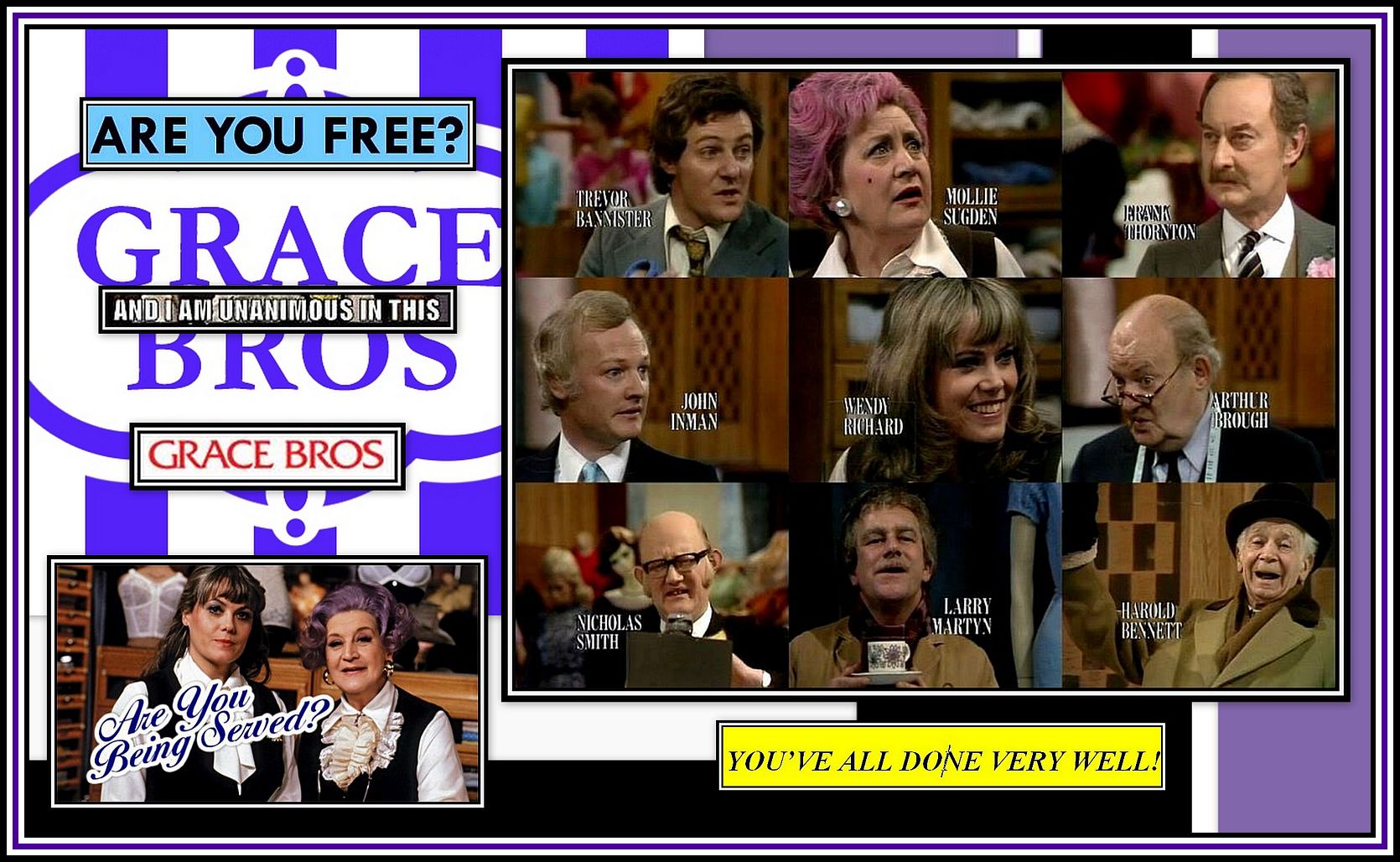 Grace Brothers Department Store
Grace Brothers Department Store
became possibly the most famous store in the world for a while thanks to
the BBC-Television Series, Are You Being Served?
Are You being Served Theme Music
-oOo-
OTHER DEPARTMENT STORES CONTINUED
-oOo-
11. DIMMEY’S OF MELBOURNE CONTINUED
-oOo-
THE PHOTO GALLERY
OF THE
DIMMEY’S DEPARTMENT STORE MURAL
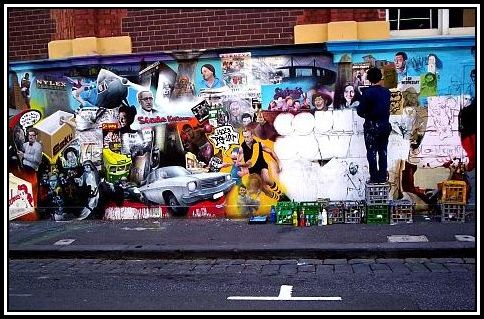 Mr. Hayden Dewar at work on the Dimmey’s Department Store Mural
Mr. Hayden Dewar at work on the Dimmey’s Department Store Mural
on the Green Street Façade of the Swan Street Store in 2008
What follows are a series of photographs that I took of the Dimmey’s Department Store Mural during visits to Melbourne in 2006 and 2008.
I was struck by the size of The Mural: 50-metres in length. Not exactly a small project and not one to be entered into lightly, yet the artist obviously approached it with great tenacity and diligence and apparently worked on it steadily in all weathers until its completion. Mr. Dewar began work on The Mural in 2004 and completed it in 2008.
Sadly for me, I was unable to name all of the figures depicted, and although Mr. Dewar did name some of my unknowns, many remain a mystery to me. Naturally I recognised Rod Laver (1938) and Margaret Court (1942; née Smith) and eventually found Evonne Goologong Crawley (1951) a little further along. I also recognised Don Bradman (1908-2001), Rolf Harris (1930), Slim Dusty (1927-2003), Geoffrey Rush (1951) and Cate Blanchett (1969) together with a few other figures including Bunyip Bluegum and Bill Barnacle.
 The Magic Pudding (published in 1918) by Normal Lindsay (1879-1969) showing
The Magic Pudding (published in 1918) by Normal Lindsay (1879-1969) showing
Bunyip Bluegum, Bill Barnacle, Penguin, The Pudding et al
However, despite my inability to name all figures, my lack of identification does not impede my full appreciation of The Mural and my admiration of the effort it took to complete.
 View of the whole length of The Mural on Green Street
View of the whole length of The Mural on Green Street
-oOo-
The theme of The Mural is the history of Dimmey’s set against the history of the State of Victoria and starts with the depiction of the beginnings of the company, as a drapery store, Dimelow & Gaylord’s, in Maryborough in 1853. Also included here are Robert O’Hara Burke (1821-1861) and William John Wills (1834-1861) who led an expedition to cross Australia from Melbourne in the south to the Gulf of Carpentaria in the north.

Also included in this section of The Mural are depictions of soldiers and mine workers from the time of the Victorian Gold Rush (1851-1860s) and the Eureka Rebellion (The Battle of the Eureka Stockage; 1854) that ensued from it. At the far right is a poster announcing the offer of a reward for the capture of Ned Kelly (1854-1880). Adjacent to the poster, the notorious Bushranger is depicted in armour and white overcoat, a disguise used to confuse those.
I am unsure of the identity of the beaded man depicted above Ned Kelly. Perhaps it is an image of Karl Marx (1818-1883) who wrote Das Kapital (Capital: Critique of Political Economy) and which was published between 1867 and 1883. However, it is more likely to be an image of an Aboriginal Australian man. It was suggested to me that he may have been a tracker working with either the police or else with the Ned Kelly Gang.
-oOo-
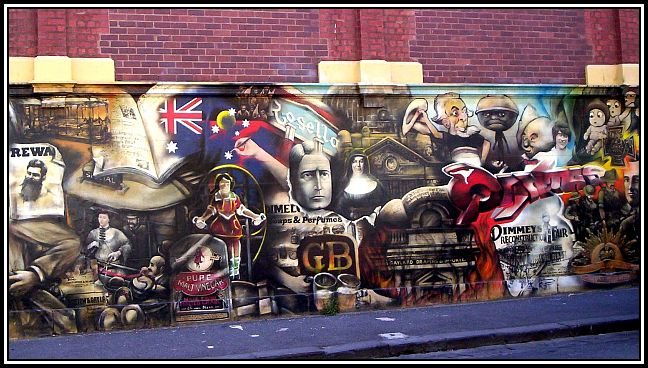
Among the illustrations depicted in this, the next section of The Mural are:
- the second attempt to introduce electric trams to Melbourne in 1906 in the top left hand corner. The first attempt to introduce this form of transportation was in 1886, but it had failed by 1896;
- the new flag of Australia, which was flown for the first time in Melbourne on the 3rd September, 1901. At this time, the Commonwealth/Federation Star was six-pointed (representing the number of States), however following the proclamation of the Territory of Papua in 1905, a seventh point was added in 1909 to represent it and future territories;

- the Skipping Girl or The Skipping Vinegar Girl, aka Little Audrey, which was used to advertise the products of Oscar Emile Nycander’s (1859-1927) vinegar brewery at Abbotsford, a suburb of Melbourne. The Skipping Girl was the first animated neon sign to appear in Australia;

- The Society of Melbourne Brewers (CUB); the Society was founded in 1903 when Carlton, Fosters, Victoria, Shamrock, Castlemaine & McCracken Breweries joined to form a Cartel. In 1907, the Society merged into a single company, the Carlton & United Breweries;
- St. Mary MacKillop (1842-1909); she together with the Reverend Julian Tenison Woods, founded the Sisters of St Joseph of the Sacred Heart (the Josephites), which established a number of schools and welfare facilities throughout Australasia;

- Flinders Street Railway Station; the new station was completed in 1909;

- the destruction of the original Dimmey’s Department Store on Swan Street by fire; The Store was rebuilt as a steel-framed building and opened for business in 1907;
- Quantas, Australia’s National Airline; the airline was founded in Winton, Queensland in 1920, as Queensland and Northern Territory Aerial Services Limited; the company’s emblem, The Flying Kangaroo, is present on the tail of the aeroplanes;

- the main characters of The Magic Pudding by Normal Lindsey; the adventures of Bunyip Bluegum, Bill Barnacle, Penguin & The Pudding first appeared in 1918 and the book has become a national treasure and enjoyed by children and adults around the world including me;
- the Gumbut Babies, Snugglepot & Cuddlepie; these delightful characters are characters in the books of Cecilia Mary Gibbs (1877-1969); and

- at the bottom right hand corner of this section, The Gallipoli Campaign (detailed below) is depicted:
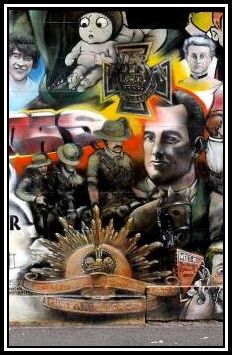
-oOo-
In 1915, Australian and New Zealand (ANZAC) soldiers formed part of an Allied expedition to capture the Gallipoli Peninsula and Constantinople (later Istanbul) and so gain passage to the Black Sea. Unfortunately, The Gallipoli Campaign was a failure, and many died. Although this was the case, the ANZAC soldiers left a powerful legacy. Each 25th April (ANZAC Day), the events of the Campaign and the fallen are solemnly remembered in those countries involved in the conflict.
Of special note in this section of The Mural is the depiction of John (Jack) Simpson Kirkpatrick (1892–1915), seated on a donkey, who was a stretcher bearer during the Campaign. He used donkeys to carry the wounded to the beach for evacuation and continued his work, often under gunfire, for three-and-a-half weeks until he was killed, on 15th May, 1915. He was buried at Beach Commonwealth War Graves Commission Cemetery at the southern end of Anzac Cove on the Gallipoli Peninsula. Since his death, he and his donkey have passed into legend. For a number of years, there was much debate to have him awarded the Victoria Cross or the Victoria Cross of Australia for valour.
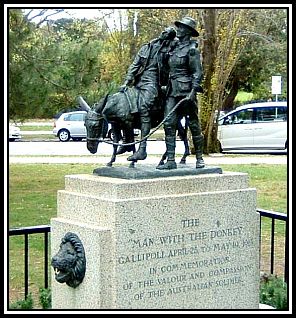 The Man with the Donkey, Melbourne War Memorial
The Man with the Donkey, Melbourne War Memorial
-oOo-

Unfortunately, I am not able to identify many of the illustrations in this section of The Mural at this time. However, those that I can identify include:
- Weet-Bix & Vegemite and are shown at the bottom left hand corner of the section. Weeb-Bix (known as Weetabix in the UK) is a breakfast cereal and was developed by Bennison Osborne in the mid-1920s.
 Being a great lover of savoury foods, I have always enjoyed Marmite, and so it was natural that I would really enjoy Vegemite! For those unfamiliar with Vegemite, it is is a dark brown paste made from leftover brewers’ yeast extract with various vegetable and spice additives and was developed by Cyril P. Callister in Melbourne in 1922. Another tasty drink or spread is Bovril, which is made from meat extract.
Being a great lover of savoury foods, I have always enjoyed Marmite, and so it was natural that I would really enjoy Vegemite! For those unfamiliar with Vegemite, it is is a dark brown paste made from leftover brewers’ yeast extract with various vegetable and spice additives and was developed by Cyril P. Callister in Melbourne in 1922. Another tasty drink or spread is Bovril, which is made from meat extract.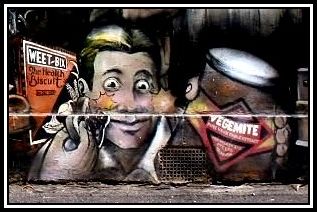
- Joseph Theodore Leslie ‘Squizzy‘ Taylor (1888–1927) was a gangster: he was a habitual criminal and in 1921 was involved in a bank robbery where the bank manager was murdered;
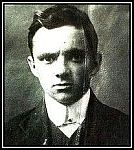
- Sir Don Bradman (1908-2001); he was a cricketer and is considered to be the greatest batsman of all time with a Test Batting Average of 99.94;

- Blinky Bill: he is a Koala Bear and children’s fictional character created by author and illustrator Dorothy Wal (1894-1942) and first appeared in print in 1933; Bill is still going strong and has recently appeared in the film, Blinky Bill the Movie, released in September 2015, and will also be the subject of a television series to be present in 2016 on Australia’s Seven Network;

- Peleco Clothing Factory: Peleco is a clothing manufacturing company that was founded in Melbourne in 1910 by James Kerr Pearson (1881-1950) and James Lindsay Gordon Law (1881-1963). The company built a factory at 21-31 Goodwood Street in Richmond and established its Head Office here. In 1939, the Pelaco Neon Sign was erected, which has become a Heritage Victoria–listed landmark. Today, the factory building is used by a number of other companies including a radio station;

- Phar Lap (1926-1932) was a Thoroughbred racehorse who dominated Australian horse racing and won a Melbourne Cup, two Cox Plates, an Australian Derby, and 19 other weight for age races. The name, Phar Lap, means Lightning (Sky Flash) in Zhuang and Thai. In 1932, the horse developed a mysterious illness and died soon after. At this time, he was the third highest stakes-winner in the world;

- Sir Robert Gordon Menzies (1894-1978): he was the twelfth Prime Minister of Australia and served in this capacity from 1939 to 1941 and again from 1949 to 1966, serving over eighteen years in total. In 1938, he was ridiculed and nicknamed, Pig Iron Bob, as a result of his industrial battle with waterside workers who refused to load scrap iron being sold to Japan;

- a group of marching soldiers: presumably this represents Australian’s entry into the Second World War (1939-1945); and
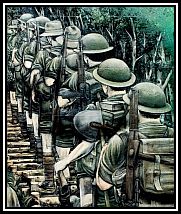
- in the top right hand corner, a Garden Mower and a Clothes Line: I have searched the Internet regarding Australian Garden Mowers and found the Victa Lawn Mower, which was invented in 1952 by Mervyn Victor Richardson in Concord, a suburb of Sydney. I have to admit that my own Garden Mower looks remarkably like the Victa! Regarding the Clothes Line: I have found reference to both Gilbert Toyne (1888-1883) who, according to the Australian Broadcasting Corporation, was the true inventor of the Rotary Clothes Line in 1925 and to the Hills Hoist. Both clothes lines were designed to allow the compact hanging of wet clothes and the exposure of the maximum area to drying by wind rotation. I remember that I was happy to find such a Rotatory Clothes Line in my garden when I moved to my present home. I have had to restring it only once during the past fifteen years, which is not bad!
 Top Left: Gilbert Toyne’s Clothes Line: Top Right: The Hills Hoist
Top Left: Gilbert Toyne’s Clothes Line: Top Right: The Hills Hoist
Bottom Left: My Rotatory Clothes Line: Bottom Right: The Victa Garden Mower
-oOo-
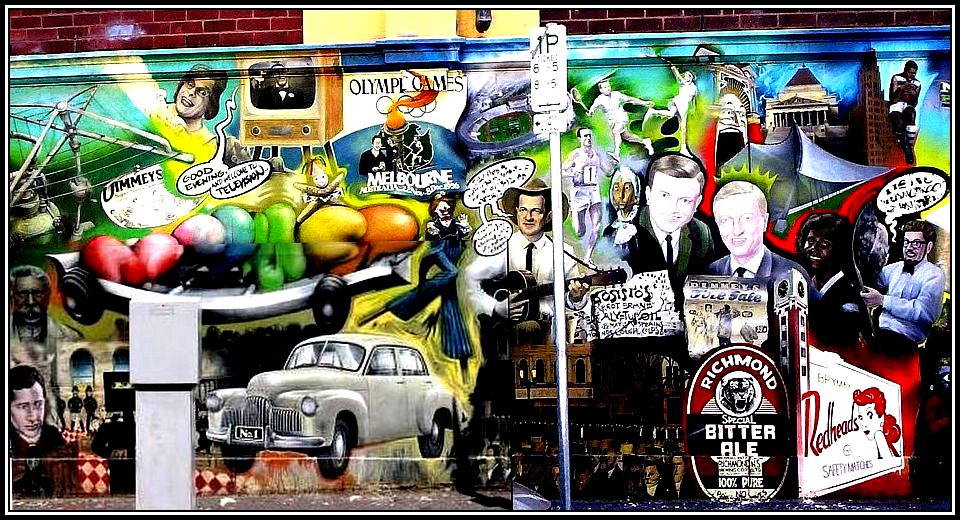
Once again, I am unable to identify all of the illustrations in the next part of The Mural, but those that I can include:
- Sir Sidney Nolan (1917–1992): the artist is shown in the bottom left hand corner today with a representation of his painting, The Trail (1947), which depicts Ned Kelly (1854-1880) in his armour;

- The FX Holden: this vehicle was a robust and economical family sedan and is one of the more prominent artifacts of 1950s Australia. The car went into production in 1948 and was named after the first chairman of the company, Sir Edward Holden (1885-1947) with two million vehicles being produced by 1968. Production of this model ceased in 1953;

- Television: this medium was first introduced in an experimental capacity to Australia in 1929, however mainstream emissions did not begin until 1956 with Bruce Gyngell (1929-2000) saying Good evening, and welcome to television. Both Mr. Gyngell and these words are depicted on The Mural;
- The Summer Olympics Games of 1956 (Games of the XVI Olympiad): these games were held in Melbourne except for the Equestrian Events that had been held in Stockholm five months earlier and were the first such games to be held in the Southern Hemisphere. Both Betty Cuthbert (1938) and Murray Rose (1939-2012) each won three gold medals for Australia;
- Herb Elliott (1938): he is considered to be one of the greatest Middle Distance Runners of his time and set the World Record for the One Mile Run at 3 minutes 54.5 seconds in August 1958. He won a gold medal at the Summer Olympics of 1960 in Rome and during his athletic career (1957-1961) he was never beaten in the One Mile and 1,500 metres run;

- Rod Laver (1938) & Margaret Court (1942 ;née Smith): these two athletes rank amongst the greatest tennis players of all time. Melbourne Park, which is part of the Melbourne Sports and Entertainment Precinct, is home to the Australian Open Tennis Tournament and has two large Arenas named for these players. The Rod Laver Arena (Centre Court) has a seating capacity of 15,000 and the Margaret Court Arena (Show Court 1), 7,500;
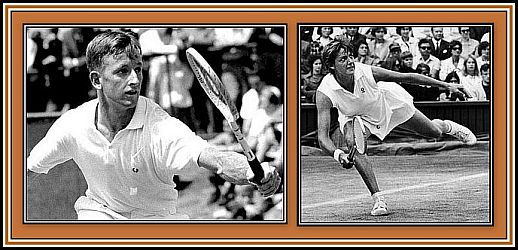
- The Moomba Festival: this is Australia’s largest free Festival has been held in Melbourne each year since 1955. Apparently, Moomba means Up Your Bum in many local Aboriginal languages. The Festival includes of a parade, fireworks displays, carnivals in the gardens along the Yarra River, river activities including water sports & floats and lots of music;
- Richmond Bitter Beer: the Richmond N.S. Brewing Company Limited was founded by Peter Grant Hay (1879-1961) and became one of the most successful breweries in Australia. Following his death, his widow sold the Company to Carlton & United Breweries in 1962;
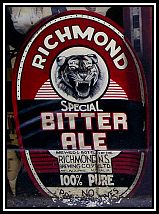
- Bryant & May Safety Matches: the building once occupied by the Bryant & May Factory in Melbourne was originally called Empire Works when built in 1909 to the design of the architect, William Pitt (1855-1918). It was soon taken over by Bryant & May who added to it and also had built the clock tower. Redheaded Matches were made here until the 1980s when production ceased;

- The Shrine of Remembrance: this memorial to the men and women of the State of Victoria who served in the First World War was dedicated on the 11th November, 1934, Remembrance Day. Today, The Shrine is now a memorial to all Australians who served in war;

- Luna Park: this is an Amusement Park located on the foreshore of Port Phillip Bay in St Kilda and has been open almost continuously since its opening in December 1912 Luna Park houses the the oldest continually operating Scenic Railway (Roller Coaster) in the world, but is not the oldest, this being Leap the Dips at Lakemont Park, Altoona, Pennsylvania in the U.S. Although not the oldest, it is one of the few remaining Railways in use that requires a Breakman to stand in the middle of the train;

- Two men that I assume were associated with Dimmey’s Department Store are illustrated, but I have been unable to determine who they were and what were their duties;
- Slim Dusty (born David Gordon Kilpatrick; 1927-2003): he was an Australian country singer who was known internationally for his 1957 recording of the song, A Pub with No Beer by Gordon Parsons, Dan Sheahan & Chad Morgan;

- and Rolf Harris (1930): I remember Mr. Harris when he first came to England; he appeared on BBC Children’s Television and would entertain with stories and drawings, one of which, Willoughby, came to life each week; he went on to record a number of songs that were well-received, the most famous being, Tie Me Kangeroo Down, Sport. Unfortunately, his career has been marred and he is currently serving a prison sentence.

-oOo-
 My last photograph of The Mural was taken in early 2008
My last photograph of The Mural was taken in early 2008
A photograph of the finished section may be found a little further down the page
Mr. Dewar had not finished The Mural during my second visit to Melbourne. He was to complete it later that year. Again, I am unable to identify every illustration in this section of The Mural, but those that I can include:
- The Nylex Clock: this an neon sign that was placed on top of Malting Storage Silos in Cremorne, a suburb of Melbourne. The Clock was restored and returned to working order in 2004 and is now listed in the Victorian Heritage Register;
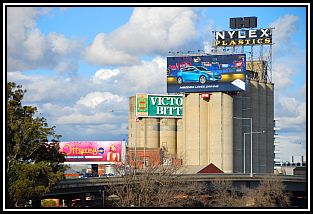
- The Royal Flying Doctor Service: I assume that the aeroplane illustrated in the top-left hand part of this section illustrated this service. The Service was formed by the Reverend John Flynn (1880-1951) in 1928 as the AIM Aerial Medical Service, which was a one-year experiment based in Cloncurry, Queensland and which later became The Royal Flying Doctor Service;

- Skippy, the Bush Kangaroo: this was an Australian television series about a young boy and a kangaroo, a wild female Eastern Grey Kangaroo. The series was produced between 1967 and 1969 and was also shown in a number of countries;
 Click here to hear the signature tune of the series
Click here to hear the signature tune of the series
- W Class Trams: this class of Electric Tram was introduced to the city by the Melbourne and Metropolitan Tramways Board (MMTB) between 1923 and 1956. A total of 752 vehicles consisting of twelve sub-classes, which the majority were constructed at the Preston Workshops of the MMTB;

- Stirling Moss (1929): the Formula One racing driver is depicted in a vehicle in British Racing Green livery;

- The Holden HQ: this series replaced the Holden HG and a total of 485,650 vehicles were produced in Australia from 1971 to 1974 before being replaced by the Holden HJ series; and
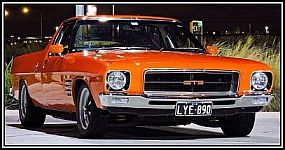
- Evonne Goolagong Crawley (1951): a great tennis player who won fourteen Grand Slam titles (seven in singles, six in doubles and one in mixed doubles) and who was always a great favourite with the crowd and me.

-oOo-
The following photograph shows this section of The Mural in its completed form. Again, and unfortunately, I am unable to recognise any of the additions.
 The above mentioned Uncompleted Section is shown here in Completed form
The above mentioned Uncompleted Section is shown here in Completed form
- I am told here that Australia’s 21st Prime Minister, Gough Whitlam (1916-2014), is depicted in this section. Unfortunately, I am unable to recognise him there. Mr. Whitham was Australia’s Prime Minister from 1972 to 1975 and marked the first time the Labour Party were in power for the first time in twenty-three years. He led the party from 1967-1977.
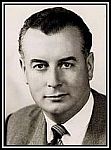
-oOo-
- The remainder of this section of The Mural appears to be given over to entertainers and sports people. Countdown was an Australian musical programme produced in Melbourne by the Australian Broadcasting Corporation (ABC) and shown from 1974-1987. The programme commanded a huge and loyal audience and had a strong influence on radio programming because of the amount of Australian content it featured. It was also one of the first Australian television series to be made entirely in colour and one of the first musical programmes to promote the regular use of the music video. The final episode of Countdown was shown on 19th July, 1987; and

- The Rabbiteers: Sir George Russell ‘Tass’ Drysdale (1912-1982) was a renowned Australian artist who painted The Rabbiters in 1947. The painting is illustrated at the bottom right-handed corner of this section if The Mural. In 1950, he had an exhibition in London, which helped demonstrate to the British Critics that Australian artists had a distinct vision of their own and not just a provincial sub-species of British art.

-oOo-
Again, I am unable to identify any of those illustrated in the next section of The Mural, I am sorry to say, except for Robert DiPierdomenico:

- Robert DiPierdomenico, aka Dipper: Mr. DiPierdomenico (1958) was an Australian Rules Football player between the 1970s and 1990s. Following his retirement from Football, he became a popular media personality and appeared on advertising campaigns for Dimmeys & Forges where his catchphrases in television and radio commercials were Be there! and $9.99!

Click here to watch an advertisement featuring Mr. Dipierdomenico
-oOo-

This is the final section of The Mural and again there are a number of illustrations that I am unable to identify. However …….
- I am able to identify a number of actors that are featured here including Cate Blanchett (1969), Geoffrey Rush (1951) and Heath Ledger (1979-2008) who is shown as Ned Kelly. These actors enjoy an international reputation;
- Cathy Freeman (1973), an Australian sprinter, is also depicted lighting the Olympic Cauldron at the opening of the XXVII Olympiad in Sydney in 2000;
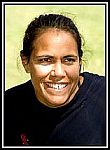
- I suspect that the cricketers shown in The Mural are the Australian National Team perhaps after winning The Ashes in England in 2001;
 The Urn holding The Ashes
The Urn holding The Ashes
- Crikey! Finally, I am able to identify Steve Irwin (1962-2006), who was known throughout the world as The Crocodile Hunter. Mr. Irwin was a wildlife expert and conservationist and who became a television personality through the wildlife documentary television series, The Crocodile Hunter. His exuberant personality and his enormous enthusiasm for his work helped make this series an international success. In addition, he was involved in a number of conservation projects throughout the world. Tragically he was killed in September 2006 while filming an underwater documentary.
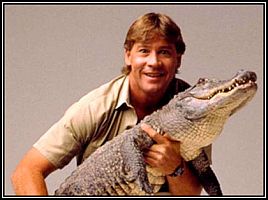
-oOo-
The illustration shown at the bottom right hand side of this section of The Mural depicts the artist, Mr. Hayden Dewar, with the untouched façade stretching up towards Swan Street.
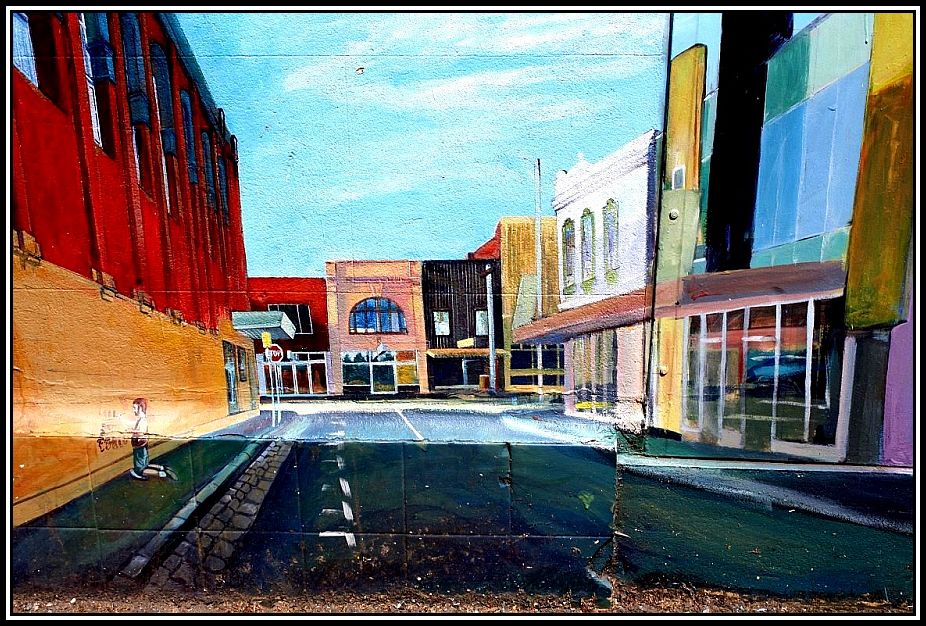
-oOo-
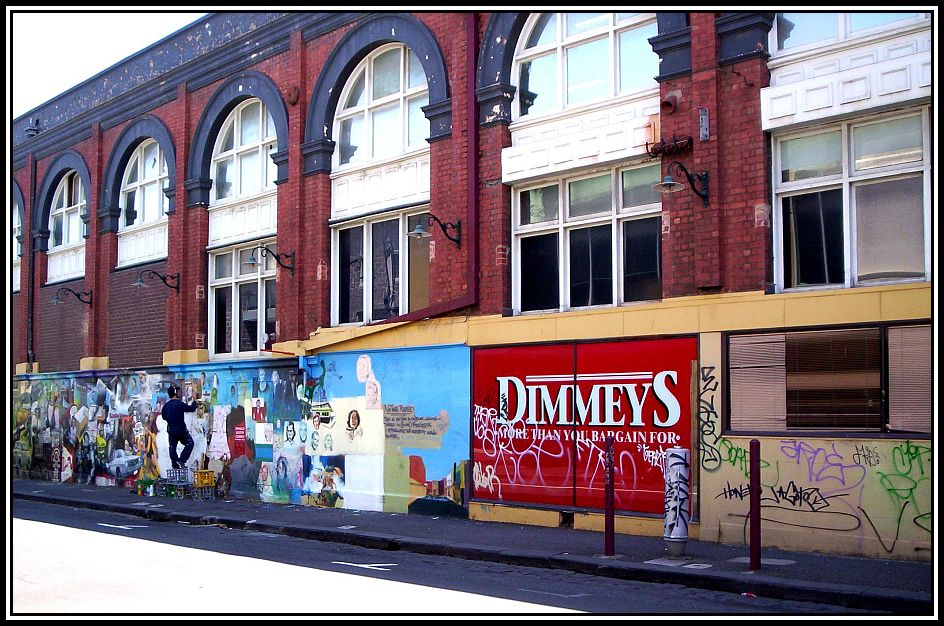 Showing Mr. Dewar at work on the final sections of The Mural during my last visit
Showing Mr. Dewar at work on the final sections of The Mural during my last visit
Note the vandalism of the Dimmey’s Sign and on the wall adjacent
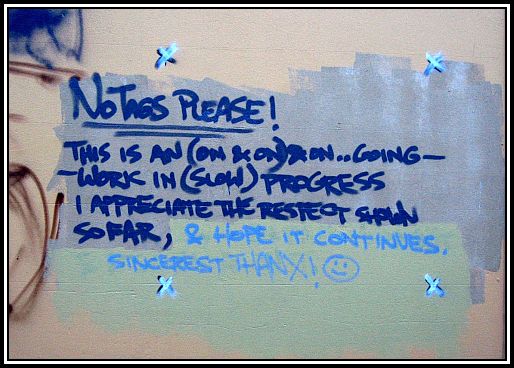 Above Mr. Dewar’s illustration of himself at the start of the project, he has written a request aimed at would-be-vandals asking them to please not deface his work. He told me that, up until that time, his request has been respected.
Above Mr. Dewar’s illustration of himself at the start of the project, he has written a request aimed at would-be-vandals asking them to please not deface his work. He told me that, up until that time, his request has been respected.
-oOo-

-oOo-
Although the building and Clock Tower are both listed as being architecturally significant, however The Mural only gets a Heritage mention. I hope that one day soon, the powers in charge of bestowing such honours soon learn that The Mural more than merits the same listing.
Finally, I would like to congratulate Mr. Dewar on creating this Mural and thank him for producing such a work for us to enjoy.
-oOo-
CLICK HERE
TO GO TO
THE FINAL DAYS OF DIMMEY’S ON SWAN STREET
——oooOOOooo——
ACKNOWLEDGEMENTS
I would like to thank Mr. Kenneth Henderson and Mr. Raymond Bridgewater for their helpful discussion in the preparation of this series.
——oooOOOooo——
Click here to GO to OTHER DEPARTMENT STORES – 11
THE FINAL DAYS OF
DIMMEY’S ON SWAN STREET
——oooOOOooo——
Click here to return to OTHER DEPARTMENT STORES – 11
THE MURAL ON GREEN STREET
——oooOOOooo——
Click here to return to THE DEPARTMENT STORE HOME PAGE
——oooOOOooo——
Click here to return to the TABLE OF CONTENTS
——oooOOOooo——

This section of the Dimmeys Richmond story is full of so many names that I grew up knowing from the 1950s and, sadly, their original origins are obscure to current history. Even the humble Victa lawnmower, an Australian invention, is believed made off shore today. I could not have assembled such a montage as is here but the compiler has done an excellent job and I am happy to have supplied information about some of these once famous Australian names.